Sony VAIO SE: An IPS Laptop for Under a Grand
by Jarred Walton on April 3, 2012 5:40 PM ESTThe Sony VAIO SE LCD: IPS++, Gamut--
We’ve saved the best for last. Really, this is the major selling point for me, and in fact I’m more than willing to overlook other concerns just for the display on the VAIO SE. Yes, there are other laptops out there with IPS displays, but the professional grade workstations with such panels can easily set you back several grand, and the next closest competitor is Lenovo’s X220. The X220 is clearly targeting a different market (primarily business users), as there’s no optical drive and no discrete GPU, plus it runs at 1366x768 and will still cost $1250 with the premium panel (IPS) upgrade. HP’s Envy 15 with the 1080p Radiance display is another laptop with an IPS panel (reportedly the same panel used in the VAIO SE, only with a glossy sheet of glass placed in front of it), and it also starts at $1250 once you make the LCD upgrade. In other words, if you want an IPS display on a mainstream laptop, there aren’t many viable alternatives right now.
So just how good is the IPS display? If you’re hoping for something that can rival a nice desktop (e.g. non-TN) display, prepare to be disappointed, but compared to pretty much any TN panel laptop it’s a hands down winner. Viewing angles are good, so you can finally look at the display from above or below without getting massive color shifting and/or loss of contrast. Contrast and brightness are also good. The weakest area is arguably the color gamut and color reproduction, but while a 70% or even 95% NTSC color gamut would be nice, given the balancing act between price, panel type, and color gamut I think Sony made the right call here.
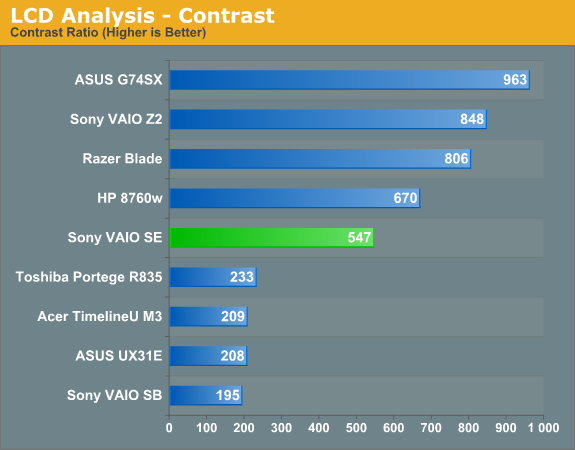
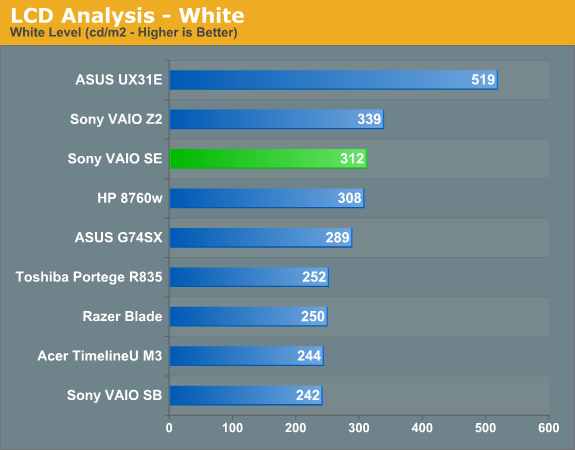
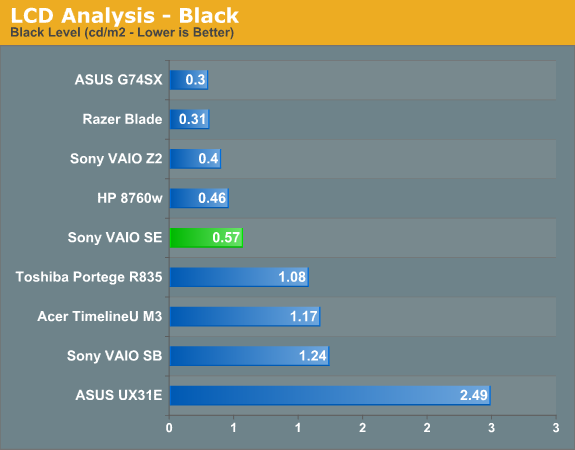
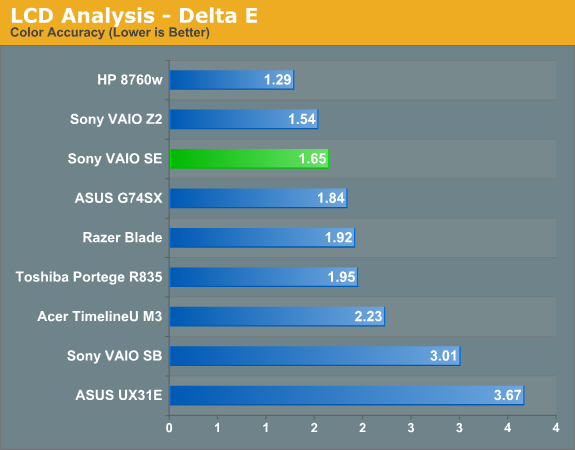
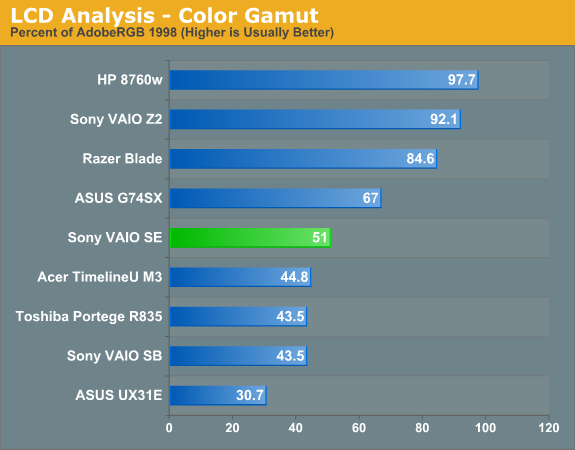
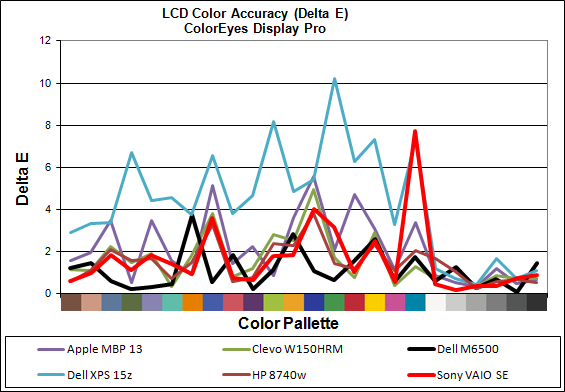
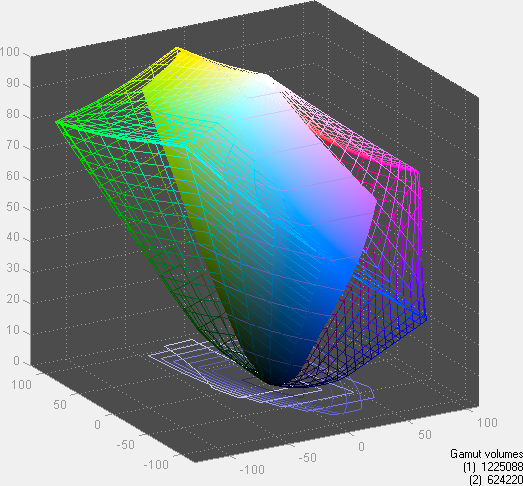
I’m a sucker for a good display—I use a 30” IPS display for my desktop, after all. The VAIO SE isn’t going to rival a 30” desktop display, but at least it has a good resolution and viewing angles, good contrast, and colors that at least match or exceed what you’ll get from 99% of laptops. Oh, and did I mention the LCD also has a matte (anti-glare) coating? Look at the viewing angles and compare them to other laptops (or watch a video like this one—sorry if you can’t understand German, but all you really need to do is watch) and you can see exactly why IPS is superior to TN. Asking for more at this point—especially with a starting price of under $1000—is probably being greedy, but seriously: this is what all laptops should be shipping as a baseline in 2012!
We’ve had decent quality TN panels for at least six years—I know the first high-end laptop I reviewed had a 1920x1200 LCD with good contrast way back in 2006, for cryin’ out loud! We started writing about (mostly complaining about) laptop LCDs in 2007, and roughly five years later what do we have to show for it? Most laptops still ship low contrast, low resolution displays, and the only thing that has universally improved is maximum brightness—and that's mostly thanks to the use of LED backlighting and often at the cost of contrast. It’s great to see that Sony understands the importance of a good laptop LCD, though obviously they have plenty of other laptops that still use “typical junk” LCDs as well. If you want to send the industry a message about the importance of LCD quality on a laptop, buying laptops like the VAIO SE is one of the best ways to make your feelings known.
What About the Colors?
With all the good aspects of the display, it’s important to realize that it’s not perfect. Much ado has been made about the HP Radiance display in the latest Envy 15, specifically that it has an orange/blue skew on red/violet colors. The VAIO SE panel appears to be the same IPS panel, and as you’d expect there’s also some color quality inaccuracies. I’ve taken a couple comparative photos to show you exactly what’s wrong with the color red, with an (old!) Dell 3007WFP (sRGB gamut) display and an HP LP3065 (95% NTSC gamut) showing the same image. I also took a photo of an ASUS K53E in front of the HP to illustrate what you typically see with a lower quality LCD. And speaking of lower quality LCDs, there’s a final image comparing black levels of the VAIO SE to the black levels of the Dell Vostro V131 (both are matte panels), which should help you understand just how bad black levels are on “typical” LCDs.
You can see in the gallery that the VAIO SE reds are clearly shifted more towards orange than the 3007WFP or LP3065. To quote my (nine year old) daughter’s analysis of the three displays: “[The Dell] picture looks sort of orange. [The Sony laptop] looks…even more orange? I dunno, it’s a weird shade of orange. And [the HP] looks red.” At the same time, the ASUS K53E is more pinkish than red and the lack of contrast is noticeable even in a picture of a picture. My daughter called the ASUS a “lighter red.” So yes, even a nine year old can readily see the color differences between the various displays. What it comes down to is this: what do you value most in a display?
A TN panel can give you a decent image when you’re looking straight on, but when viewed from above or below TN panels are notoriously bad. Even the best TN panels—e.g. the AUO B156HW01 v4 used in laptops like the Lenovo W520 and Clevo W150HRQ—are still going to offer a less than stellar experience with off-angle viewing, despite having a wide color gamut. As you can see in the above gallery, the VAIO SE panel (61% sRGB gamut) doesn’t reproduce perfect colors. It’s not terrible, but if you’re an image or video professional and you want to have accurate colors, you’ll need something better than this.
Look at the results from the Dell M6500 display and the HP EliteBook and you can see whay professional displays deliver. For less demanding users, your eyes will mostly adapt to what you see on the screen, so while red might look orange, orange will look like something else and it all (mostly) works out. I can immediately notice the lack in contrast on a laptop without running any specialized tests; for color accuracy, though, it’s something I generally notice only when there’s a reference point nearby.
TL;DR: There’s a reason Dell and HP charge so much for their professional IPS displays on their Precision and EliteBook workstations. As nice as it is to have a $1000 laptop with a decent IPS display, you won’t get the same quality LCD as you would on something like the HP DreamColor. Or in other words: you still get what you pay for.






















59 Comments
View All Comments
ckryan - Tuesday, April 3, 2012 - link
This is some of the best news I've heard in a while.My perfect lappy would be something with a 14.1" IPS display at 16:10, somewhere in the neighborhood of 1440x900.
I don't think that is all that much to ask, and even eIPS is cool with me. Anything better than the awful TN panels out there.
I don't mind lower resolution as much in a laptop, at least to a certain extent. Windows 7 is ill-equipped to really make the most of high resolution displays in smaller screen sizes anyway.
peterfares - Tuesday, April 3, 2012 - link
"I don't mind lower resolution as much in a laptop, at least to a certain extent. Windows 7 is ill-equipped to really make the most of high resolution displays in smaller screen sizes anyway. "Why do people keep saying this? I've used Windows 7 with high DPI mode and it works flawlessly in my experience.
freedom4556 - Tuesday, April 3, 2012 - link
You must be nearly blind. It works terribly in my experience across many different displays, VGAs, and DPI settings. It's not Windows' fault, the apps just don't play nice with a DPI change.JarredWalton - Wednesday, April 4, 2012 - link
I'd say it's probably about 50-50 for apps playing well with the DPI setting. Most MS apps are fine, obviously, and the web works well for me. But there are definitely major applications where playing with the DPI setting causes issues. I have a 30" LCD and for a while I used the 125% DPI setting, but eventually I got sick of the glitches here and there and went back to the default scaling.Samus - Wednesday, April 4, 2012 - link
Windows 7 with big desktop icons and high dpi is no comparison to Windows xp's "stretch only supported GDI objects disproportionally to others".hemmy - Wednesday, April 4, 2012 - link
I think Windows 7 is great with high-res displays. Everything looks so crisp and small with tons of open screen space.laptop under - Saturday, October 7, 2017 - link
I totally agree with you. Visit <a href="https://laptopunder.net/">Laptop Under</a> if you are looking for best one.Machelios - Tuesday, April 3, 2012 - link
If only there was a hybrid hdd on this. Though, I think it is a bad decision to do only 1x4GB sticks. The performance will degrade in some applications. 2x2GB is better. I also wish there was an option without a CD Drive. The hinge problem is sad. It could have reached perfection.oh... and FIRST!
I know you guys will hate. I cannot wait.
kyuu - Tuesday, April 3, 2012 - link
Considering you're not actually first, I fully expect some hate as well. ;)But I agree, I wish manufacturers would start including an option for a hybrid HDD. The thing I hate most about buying a laptop is having to pay for the crappy HDD they stick in which I'm going to want to swap out first thing.
DigitalFreak - Tuesday, April 3, 2012 - link
"I know you guys will hate. I cannot wait."Being stupid is your fate. Now run along home and don't be late.